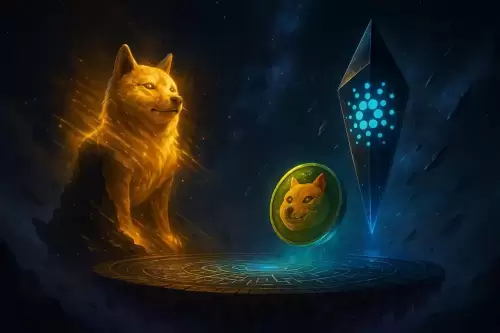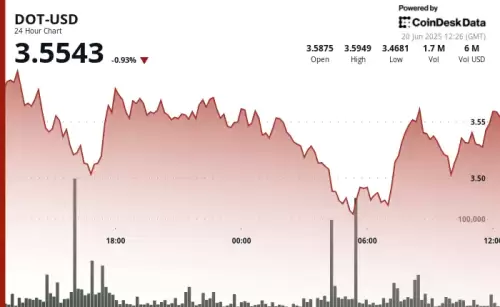 |
|
 |
|
 |
|
 |
|
 |
|
 |
|
 |
|
 |
|
 |
|
 |
|
 |
|
 |
|
 |
|
 |
|
 |
|
Web3的零散景觀是UX的噩夢。但是,跨鏈技術的創新為用戶友好的未來鋪平了道路。讓我們潛入!

Web3 promised a decentralized utopia, but delivered a fragmented mess. Cross-chain interoperability isn't just a tech upgrade; it's the foundation for Web3's mainstream future.
Web3答應了一個分散的烏托邦,但散佈了一團糟。跨鏈互操作性不僅僅是技術升級;這是Web3主流未來的基礎。
The Web3 Fragmentation Fiasco
Web3碎片慘敗
Right now, Web3 feels like navigating a maze. You need a different wallet for every chain, each with its own rules and tokens. Imagine holding Bitcoin in a hardware wallet, trading Ethereum tokens on MetaMask, and staking Cardano via Lace Wallet. Each step requires manual bridging, fee calculations, and constant security checks. It’s not just inconvenient; it's a systemic failure.
目前,Web3感覺就像在迷宮一樣。您需要為每個鏈條,每個鏈條,都有自己的規則和令牌。想像一下,在硬件錢包中握住比特幣,在metamask上交易以太坊代幣,並通過蕾絲錢包堆放卡丹諾。每個步驟都需要手動橋接,費用計算和持續的安全檢查。這不僅是不便的;這是系統的失敗。
Even addresses are a headache! Ethereum uses hexadecimal, Bitcoin uses Base58, and newer chains invent their own. Galaxy researchers call this "asset fragmentation," where tokens bridged across chains become non-fungible and confusing. It's like the Tower of Babel, where chains can barely talk to each other.
甚至地址都是頭痛!以太坊使用十六進制,比特幣使用base58,而較新的鏈發明了自己的鏈條。銀河研究人員稱這種“資產碎片化”,在跨鏈條上橋接的令牌變得不可殺死和令人困惑。就像巴別塔一樣,連鎖店幾乎無法互相交談。
Transaction Fees: The Silent UX Killer
交易費:沉默的UX殺手
Cross-chain transactions come with a hidden tax: fees. You pay on the source chain, the destination chain, and for relay services. If you're not careful, fees can eat up the value of your transfer. ERC-20 swaps on Ethereum can hit $10 during peak times, and even layer-2 bridging adds complexity.
跨鏈交易帶有隱藏的稅收:費用。您可以在源鏈,目的地鍊和中繼服務上付款。如果您不小心,費用可能會吞噬轉移的價值。 ERC-20在以太坊上的掉期在高峰時段可能達到10美元,甚至第2層橋接也會增加複雜性。
Solutions like Arbitrum and Optimism offer some relief, cutting fees by up to 95%. But Solana's co-founder points out that they also add fragmentation. Bridging USDC from Arbitrum to Polygon still means dealing with different architectures and completion times. True interoperability needs to abstract these complexities, not just optimize them.
仲裁和樂觀等解決方案提供了一些緩解,將費用削減多達95%。但是Solana的聯合創始人指出,它們也增加了分裂。將USDC從仲裁到多邊形仍然意味著處理不同的架構和完成時間。真正的互操作性需要抽像這些複雜性,而不僅僅是優化它們。
Towards a Chain-Agnostic Nirvana
朝向鏈條涅rv的涅rv
The real goal isn't just cross-chain transactions, but chain-agnostic ones. Users should access DeFi pools, NFT markets, and DAOs through unified interfaces. Imagine a wallet that picks the cheapest chain for swaps, routes transactions over optimal bridges, and consolidates fees into one stablecoin payment, all while keeping your assets secure.
真正的目標不僅僅是跨鏈交易,還包括鏈條不合時宜的交易。用戶應通過統一界面訪問Defi池,NFT市場和DAO。想像一下,一個錢包可以選擇最便宜的鏈條進行交易,交易與最佳橋樑相比,並將費用整合為一筆穩定的付款,同時確保您的資產安全。
This requires innovations like DeFAI. If interchain transactions were seamless, AI agents could handle most DeFi transactions. We're not there yet, but it's the vision.
這需要像Defai這樣的創新。如果鏈交易是無縫的,則AI代理可以處理大多數Fefi交易。我們還沒有到達,但這是願景。
Smart contracts should run cross-chain without wrappers, and decentralized identities should move frictionlessly between ecosystems. We need super wallets that unlock the full potential of Web3.
智能合約應在沒有包裝紙的情況下運行跨鏈,而分散的身份應在生態系統之間無摩擦。我們需要超級錢包來解鎖Web3的全部潛力。
Security: The Non-Negotiable Pillar
安全:不可談判的支柱
Interoperability can't come at the cost of security. Cross-chain bridges are prime targets, with over $2 billion stolen in 2023 alone. Centralized validators and opaque code are a no-go. New cryptographic tools, like zero-knowledge proofs, can verify cross-chain events without trusted middlemen.
互操作性不能以安全為代價。跨鏈橋是主要目標,僅2023年就被盜了20億美元。集中式驗證器和不透明的代碼是不做的。新的加密工具,例如零知識證明,可以在沒有信任的中間人的情況下驗證跨鏈事件。
The industry needs high security standards. We need collaborative initiatives, like the Linux Foundation’s Decentralized Trust, to create those standards. Developers must prioritize interoperability in base protocols, not as an afterthought. Users need to demand it from wallet and dApp providers.
該行業需要高安全標準。我們需要像Linux Foundation的分散信任等協作計劃來創建這些標準。開發人員必須優先考慮基本協議中的互操作性,而不是事後想法。用戶需要從Wallet和Dapp提供商那裡要求它。
Polkadot: A Layer 0 Solution
Polkadot:0層解決方案
Polkadot, launched in May 2020, is a layer 0 blockchain aiming to create an "internet of blockchains." It uses a multi-chain architecture with specialized blockchains called parachains that function in parallel while benefiting from the shared security of the Relay Chain.
Polkadot於2020年5月推出,是0層區塊鏈,旨在創建“區塊鏈互聯網”。它使用的多鏈體系結構具有專門的區塊鏈,稱為Parachains,在中繼鏈的共同安全性中受益,該鍊鍊並行起作用。
The DOT token is central to Polkadot, used for governance, staking, bonding, and transaction fees. This design allows blockchains to specialize while staying connected, overcoming scalability and interoperability limitations.
點令牌是Polkadot的核心,用於治理,積分,結合和交易費用。該設計使區塊鏈在保持連接時可以專業化,克服可伸縮性和互操作性限制。
The Bottom Line
底線
Blockchains need interconnection. Just like TCP/IP unified computer networks, interoperability protocols can weave isolated Web3 chains into a cohesive digital economy. The blueprints exist; what we need now is collective will.
區塊鏈需要互連。就像TCP/IP統一的計算機網絡一樣,互操作性協議可以將隔離的Web3鏈編織到凝聚力的數字經濟中。存在藍圖;我們現在需要的是集體意志。
We need to stop building isolated kingdoms and start laying the railroads between them. Only then will Web3 become user-friendly and fulfill its promise. Interoperate or stagnate, folks!
我們需要停止建立孤立的王國,並開始在它們之間鋪設鐵路。只有這樣,Web3才會變得易於使用並實現其諾言。伙計們,互操作或停滯不前!
免責聲明:info@kdj.com
所提供的資訊並非交易建議。 kDJ.com對任何基於本文提供的資訊進行的投資不承擔任何責任。加密貨幣波動性較大,建議您充分研究後謹慎投資!
如果您認為本網站使用的內容侵犯了您的版權,請立即聯絡我們(info@kdj.com),我們將及時刪除。
-

- Pepe Coin的瘋狂旅程:市場下降還是購買機會?
- 2025-06-21 00:25:13
- 隨著價格下降,佩佩硬幣面臨著關鍵的時刻。是時候購買蘸醬了,還是不可避免的市場下跌?讓我們深入研究分析。
-

-

-

- 金幣,稀有,馬:錢幣綜述
- 2025-06-20 22:45:13
- 從查爾斯二世幾內亞到凱斯花園50ps,發掘了稀有的金幣,以及他們講的有趣的故事。另外,津巴布韋的黃金硬幣計劃停止。
-

-

-

-

- Polkadot的點:導航三重底部和看漲逆轉
- 2025-06-20 23:25:12
- Polkadot的點顯示了彈性,在擊中潛在的三重底部後形成了看漲的逆轉模式。這是大規模集會的開始嗎?
-































































